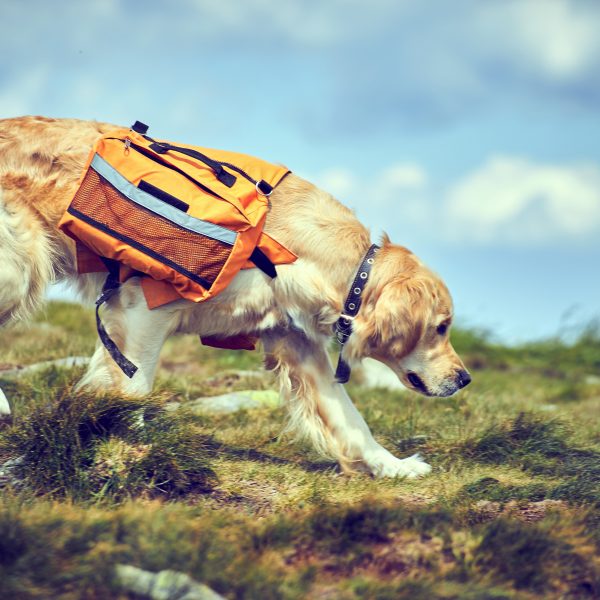Dos and Don’ts of Dog Backpacks

Dog backpacks can be a comfort for your dog when they are out and about with you. It can also give them a job to do, which satisfies the urge to work that many working and herding dogs have. On top of that, it can sometimes reduce pulling and help energetic dogs burn more energy without overheating or overexerting themselves. Here are the dos and don’ts of dog backpacks:
The Dos of Dog Backpacks
When equipping your dog with a backpack, follow these do’s in order to keep your dog safe, happy, and enjoying their new backpack.
1. Do Consult Your Vet
First and foremost, get an appointment with your veterinarian for a consultation. A dog backpack will add extra weight to your dog and so will any gear you add into the pack. It’s important that your vet clears your dog for this extra weight.
After a physical exam, your vet should also be able to provide some weight recommendations and restrictions specific to your dog. Some dogs can carry 10-12% of their body weight or more while other dogs may only be able to carry an empty backpack or may not be able to carry anything at all. A consultation with your vet will help clear up any confusion and provide answers to these questions.
2. Do Get a Backpack Designed for Dogs
Make sure you’re getting an official dog backpack* (Amazon Affiliate Link) that has been designed specifically for use by dogs. A well-made dog backpack will be built to keep your dog comfortable and safe while wearing it. It should be made of a breathable and durable material that is also water-resistant or waterproof.
It should also have proper padding on the chest band and straps. The backpack itself and any gear you include will add extra pressure on these areas, so extra padding in those areas will help ensure your dog is comfortable. A saddlebag design is also preferable as this distributes the weight evenly and does not press directly down on your dog’s back.
3. Do Figure Out What Your Dog Can Carry
Once your vet has cleared your dog and you have a dog backpack, what do you pack in it? Start out small and include your dog’s supplies in their backpack. Depending on your dog’s size and weight restrictions, you can have them carry water bottles, poop bags, toys, and more.
Avoid anything sharp or pointy as these items can jab them in the sides. Also, make sure the weight is balanced equally on both sides. You don’t want to put more pressure on one side or the other as this will cause your dog to walk unevenly, which can hurt their joints.
4. Do Start Out Small
You want to make sure you start out small and make increases gradually. The added weight of even an empty backpack will cause your dog to burn more energy than usual. So, start out with an empty backpack and a shorter walk.
Then, build up the weight in the backpack and increase to longer walks over time. This allows your dog to develop the muscles they’ll be using with the backpack and will keep them from overexerting or injuring themselves.
The Don’ts of Dog Backpacks
These are several don’ts you should avoid when equipping your pup with a dog backpack.
1. Don’t Estimate Sizing
It’s tempting to just use your dog’s weight for determining backpack size, but this does not always give you the best fit. It could result in a backpack that is too big or too small in the chest area, which could hurt your dog.
It would be really uncomfortable, at the very least. In addition to your dog’s weight, also measure around the deepest part of their chest. This will ensure the dog backpack you’re getting for your furry friend will fit properly.
2. Don’t Guess Weight
After consulting with your vet, you should have a good idea of how much weight your pup can carry. It is imperative that you do not exceed that weight. If you do, you could damage your dog’s joints and cause them pain.
Keep a scale handy and weigh yours and your dog’s backpacks to ensure each is well under your individual weight restrictions. This allows you to verify the actual weight of your gear and ensure both you and your dog stay safe.
3. Don’t Force It
Your dog will likely be resistant to the backpack initially. You don’t want to give up right away, but you also don’t want to force the backpack on your dog if they’re really not into it. Let your dog inspect the backpack and get used to being around it.
Then, let them get used to an empty backpack before you start adding weight. Once they’re used to that, gradually increase what you allow your dog to carry. If your dog is not getting on the backpack train, don’t force it.
Carrying items in a dog backpack is one of the jobs your dog can do at home. A doggie backpack can help your dog enjoy the outdoors with you, or even just enjoy a standard walk a little more. With these do’s and don’ts of dog backpacks in mind, it’s bound to be a smoother introduction and a more enjoyable experience for your dog.
*Greenfield Puppies is a participant in the Amazon Services LLC Associates Program, an affiliate advertising program designed to provide a means for sites to earn advertising fees by advertising and linking to amazon.com. Greenfield Puppies may earn a commission for purchases made through Amazon affiliate links on our site.
